Creating Futuristic Heritage Experiences: An Exploratory Co-Design Study through Design Fiction
Abstract
1. Introduction
2. Related Work
2.1. Cultural Heritage and Technology
2.2. Design Fiction
3. Design Practice
3.1. Recruitment
3.2. Activity 1: Peer Sharing
3.3. Activity 2: Literature-Based Seminar
3.4. Activity 3: Future Heritage Design Workshop
4. Results
4.1. Narrative Experiences and Role-Play Gaming
4.2. Dystopian Heritage Experience
5. Methodological Refection
5.1. The Importance of Skill Exchange
5.2. Studying Together and Knowledge Sharing
5.3. Co-Design the Experience
6. Conclusions
Funding
Institutional Review Board Statement
Informed Consent Statement
Data Availability Statement
Acknowledgments
Conflicts of Interest
References
- Dunne, A.; Raby, F. Design Noir: The Secret Life of Electronic Objects; Birkhäuser: London, UK, 2001. [Google Scholar]
- Sterling, B. Design Fiction. Interactions 2009, 16, 20–24. [Google Scholar] [CrossRef]
- Dindler, C.; Iversen, O.S. Fictional Inquiry—Design Collaboration in a Shared Narrative Space. CoDesign 2007, 3, 213–234. [Google Scholar] [CrossRef]
- Ciolfi, L.; Avram, G.; Maye, L.; Dulake, N.; Marshall, M.T.; van Dijk, D.; McDermott, F. Articulating co-design in museums: Reflections on two participatory processes. In Proceedings of the 19th ACM Conference on Computer-Supported Cooperative Work & Social Computing, San Francisco, CA, USA, 27 February–2 March 2016; pp. 13–25. [Google Scholar]
- Claisse, C. The augmented house museum: Co-exploring tangible interaction to increase engagement with heritage in house museums. In Proceedings of the 2017 ACM Conference Companion Publication on Designing Interactive Systems, Edinburgh, UK, 10–14 June 2017; pp. 380–381. [Google Scholar]
- Ferretti, V.; Gandino, E. Co-designing the solution space for rural regeneration in a new world heritage site: A choice experiments approach. Eur. J. Oper. Res. 2018, 268, 1077–1091. [Google Scholar] [CrossRef]
- Angelo, C.; Francesco, P.; Isabella, V. Smart environments and cultural heritage: A novel approach to create intelligent cultural spaces. J. Locat. Based Serv. 2015, 9, 209–234. [Google Scholar]
- Tudorache, P. The importance of the intangible cultural heritage in the economy. Procedia Econ. Financ. 2016, 39, 731–736. [Google Scholar]
- Michalakis, K.; Caridakis, G. Context Awareness in Cultural Heritage Applications: A Survey. J. Comput. Cult. Herit. 2022, 15, 1–32. [Google Scholar] [CrossRef]
- Zhao, S.; Kirk, D.; Bowen, S.; Wright, P. Cross-cultural understanding of Chinese traditional puppetry: Integrating digital technology to enhance audience engagement. Int. J. Intang. Herit. 2019, 14, 140–156. [Google Scholar]
- Wang, F. Is culture computable? IEEE Intell. Syst. 2009, 24, 2–3. [Google Scholar] [CrossRef]
- Haydar, M.; Roussel, D.; Maïdi, M.; Otmane, S.; Mallem, M. Virtual and augmented reality for cultural computing and heritage: A case study of virtual exploration of underwater archaeological sites (preprint). Virtual Real. 2011, 15, 311–327. [Google Scholar] [CrossRef]
- Davison, R. Cultural Complications of ERP. Commun. ACM 2002, 45, 109–111. [Google Scholar] [CrossRef]
- Kalay, Y.; Kvan, T.; Affleck, J. New Heritage: New Media and Cultural Heritage; Routledge: London, UK, 2007. [Google Scholar]
- Parry, R. (Ed.) Museums in a Digital Age; Routledge: London, UK, 2010. [Google Scholar]
- Lyman, P.; Besser, H. Defining the problem of our vanishing memory: Background, current status, models for resolution. In Museums in a Digital Age; Routledge: London, UK, 2013; pp. 336–343. [Google Scholar]
- Petrelli, D.; Ciolfi, L.; Van Dijk, D.; Hornecker, E.; Not, E.; Schmidt, A. Integrating material and digital: A new way for cultural heritage. Mag. Interact. 2013, 20, 59–60. [Google Scholar] [CrossRef]
- Bekele, M.K.; Pierdicca, R.; Frontoni, E.; Malinverni, E.S.; Gain, J. A Survey of Augmented, Virtual, and Mixed Reality for Cultural Heritage. J. Comput. Cult. Herit. 2018, 11, 1–36. [Google Scholar] [CrossRef]
- Sichani, A.; Hendy, D. Connected Histories of the BBC: Opening up the BBC Oral History Archive to the Digital Domain. J. Comput. Cult. Herit. 2022, 15, 1–16. [Google Scholar] [CrossRef]
- Petrelli, D.; Ciolfi, L.; Avram, G. Envisioning, designing, and rapid prototyping heritage installations with a tangible interaction toolkit. Hum.–Comput. Interact. 2021, 1–41. [Google Scholar] [CrossRef]
- Lu, Z.; Annett, M.; Fan, M.; Wigdor, D. “I feel it is my responsibility to stream”: Streaming and Engaging with Intangible Cultural Heritage through Livestreaming. In Proceedings of the 2019 CHI Conference on Human Factors in Computing Systems (CHI ’19). Association for Computing Machinery, New York, NY, USA, 4–9 May 2019; pp. 1–14. [Google Scholar] [CrossRef]
- Lombardo, V.; Pizzo, A.; Damiano, R. Safeguarding and accessing drama as intangible cultural heritage. J. Comput. Cult. Herit. JOCCH 2016, 9, 1–26. [Google Scholar] [CrossRef]
- Maye, L.A.; Bouchard, D.; Avram, G.; Ciolfi, L. Supporting cultural heritage professionals adopting and shaping interactive technologies in museums. In Proceedings of the 2017 Conference on Designing Interactive Systems, Edinburgh, UK, 10–14 June 2017; pp. 221–232. [Google Scholar]
- Zhao, S.; Kirk, D.; Bowen, S.; Wright, P. Enhancing the appreciation of traditional Chinese painting using interactive technology. J. Multimodal Technol. Interact. 2018, 2, 16. [Google Scholar] [CrossRef]
- Zhao, S. A Methodological Reflection: Deconstructing Cultural Elements for Enhancing Cross- cultural Appreciation of Chinese Intangible Cultural Heritage. In Culture and Computing. HCII 2020. Lecture Notes in Computer Science; Rauterberg, M., Ed.; Springer: Cham, Switzerland, 2020; Volume 12215, pp. 450–459. [Google Scholar]
- Desolda, G.; Ardito, C.; Matera, M. Empowering end users to customize their smart environments: Model, composition paradigms, and domain-specific tools. ACM Trans. Comput.-Hum. Interact. 2018, 24, 52. [Google Scholar] [CrossRef]
- Kanstrup, A.M. A small matter of design: An analysis of end users as designers. In Proceedings of the 12th Participatory Design Conference (PDC ‘12), ACM, Roskilde, Denmark, 12–16 August 2012; pp. 109–118. [Google Scholar]
- Turchi, T.; Malizia, A. Pervasive displays in the wild: Employing end user programming in adaption and re-purposing. In International Symposium on End User Development; Springer: Cham, Switzerland; Madrid, Spain, 2015; pp. 223–229. [Google Scholar]
- Auger, J. Speculative Design: Crafting the Speculation. Digit. Creat. 2013, 24, 11–35. [Google Scholar] [CrossRef]
- Coulton, P.; Burnett, D.; Gradinar, A. Games as Speculative Design: Allowing Players to Consider Alternate Presents and Plausible Features. In Future Focused Thinking, Drs International Conference 2016; Lloyd, P., Bohemia, E., Eds.; Design Research Society: Brighton, UK, 2016. [Google Scholar] [CrossRef]
- Dunne, A.; Raby, F. Speculative Everything: Design, Fiction, and Social Dreaming; MIT Press: Cambridge, MA, USA, 2013. [Google Scholar]
- Gualeni, S. Virtual Worlds as Philosophical Tools: How to Philosophize with a Digital Hammer; Palsgrave Macmillan: London, UK, 2015. [Google Scholar]
- Kirby, D. The Future is Now: Diegetic Prototypes and the Role of Popular Films in Generating Real-world Technological Development. Soc. Stud. Sci. 2010, 40, 41–70. [Google Scholar] [CrossRef]
- Bleecker, J. Design Fiction: A Short Essay on Design, Science, Fact and Fiction; Near Future Laboratory: USA, 2009. [Google Scholar]
- Micoli, L.L.; Caruso, G.; Guidi, G. Design of Digital Interaction for Complex Museum Collections. Multimodal Technol. Interact. 2020, 4, 31. [Google Scholar] [CrossRef]
- Nisi, V.; Bostock, H.; Casario, V.; Acedo, A.; Nunes, N. Impalpable Narratives: How to capture intangible cultural heritage of migrant communities. In Proceedings of the C&T ’21, 10th International Conference on Communities & Technologies—Wicked Problems in the Age of Tech (C&T ‘21), Seattle, WA, USA, 20–25 June 2021. [Google Scholar]
- Guttentag, D.A. Virtual Reality: Applications and Implications for Tourism. Tour. Manag. 2010, 31, 637–651. [Google Scholar] [CrossRef]
- Kinch, S.; Pakanen, M.; Heiselberg, K.; Dindler, C.; Iversen, A.-M.; Gall Krogh, P. An exploratory study of using speculative artefacts in co-design. CoDesign 2022, 1–19. [Google Scholar] [CrossRef]
- Rozendaal, M.C.; Heidingsfelder, M.L.; Kupper, F. Exploring Embodied Speculation in Participatory Design and Innovation. In Proceedings of the PDC’16, 14th Participatory Design Conference: Short Papers, Interactive Exhibitions, Workshops (PDC’16) 2, Association for Computing Machinery, New York, NY, USA, 15–19 August 2016. [Google Scholar]
- Olivier, P.; Wright, P. Digital Civics: Taking a Local Turn. Interactions 2015, 22, 61–63. [Google Scholar] [CrossRef]
- Vlachokyriakos, V.; Crivellaro, C.; Le Dantec, C.; Gordon, E.; Wright, P.; Olivier, P. Digital Civics: Citizen Empowerment with and Through Technology. In Proceedings of the 2016 CHI Conference Extended Abstracts on Human Factors in Computing Systems (CHI EA’16), San Jose, CA, USA, 7–12 June 2016; Association for Computing Machinery: New York, NY, USA; pp. 1096–1099. [Google Scholar]
- Nägele, L.; Ryöppy, V.M.; Wilde, D. Participatory Design Fiction with Vulnerable Users. In Proceedings of the NordiCHI’18, 10th Nordic Conference on Human-Computer Interaction (NordiCHI’18). Association for Computing Machinery, New York, NY, USA, 29 September–3 October 2018. [Google Scholar]
- Wakkary, R.; Odom, W.; Hauser, S.; Hertz, G.; Henry, L. Material speculation: Actual artifacts for critical inquiry. Aarhus Ser. Hum. Cent. Comput. 2015, 1, 12. [Google Scholar] [CrossRef]
- Zhao, S.; Kirk, D.; Bowen, S.; Chatting, D.; Wright, P. Supporting the Cross-cultural Appreciation of Traditional Chinese Puppetry Through a Digital Gesture Library. Comput. Cult. Herit. 2020, 12, 1–19. [Google Scholar] [CrossRef]
- Zhao, S. Exploring How Interactive Technology Enhances Gesture-Based Expression and Engagement: A Design Study. Multimodal Technol. Interact. 2019, 3, 13. [Google Scholar] [CrossRef]
- Schofield, T.; Smith, F.S.; Bozoglu, G.; Whitehead, C. Design and Plural Heritages: Composing Critical Futures. In Proceedings of the 2019 CHI Conference on Human Factors in Computing Systems, Glasgow, UK, 4–9 May 2019; Association for Computing Machinery: New York, NY, USA; pp. 1–15. [Google Scholar]
- Baumann, K.; Caldwell, B.; Bar, F.; Stokes, B. Participatory Design Fiction: Community Storytelling for Speculative Urban Technologies. In Proceedings of the Extended Abstracts of the 2018 CHI Conference on Human Factors in Computing Systems (CHI EA ‘18), Montreal, QC, Canada, 21–26 April 2018; Association for Computing Machinery: New York, NY, USA; p. 1. [Google Scholar]


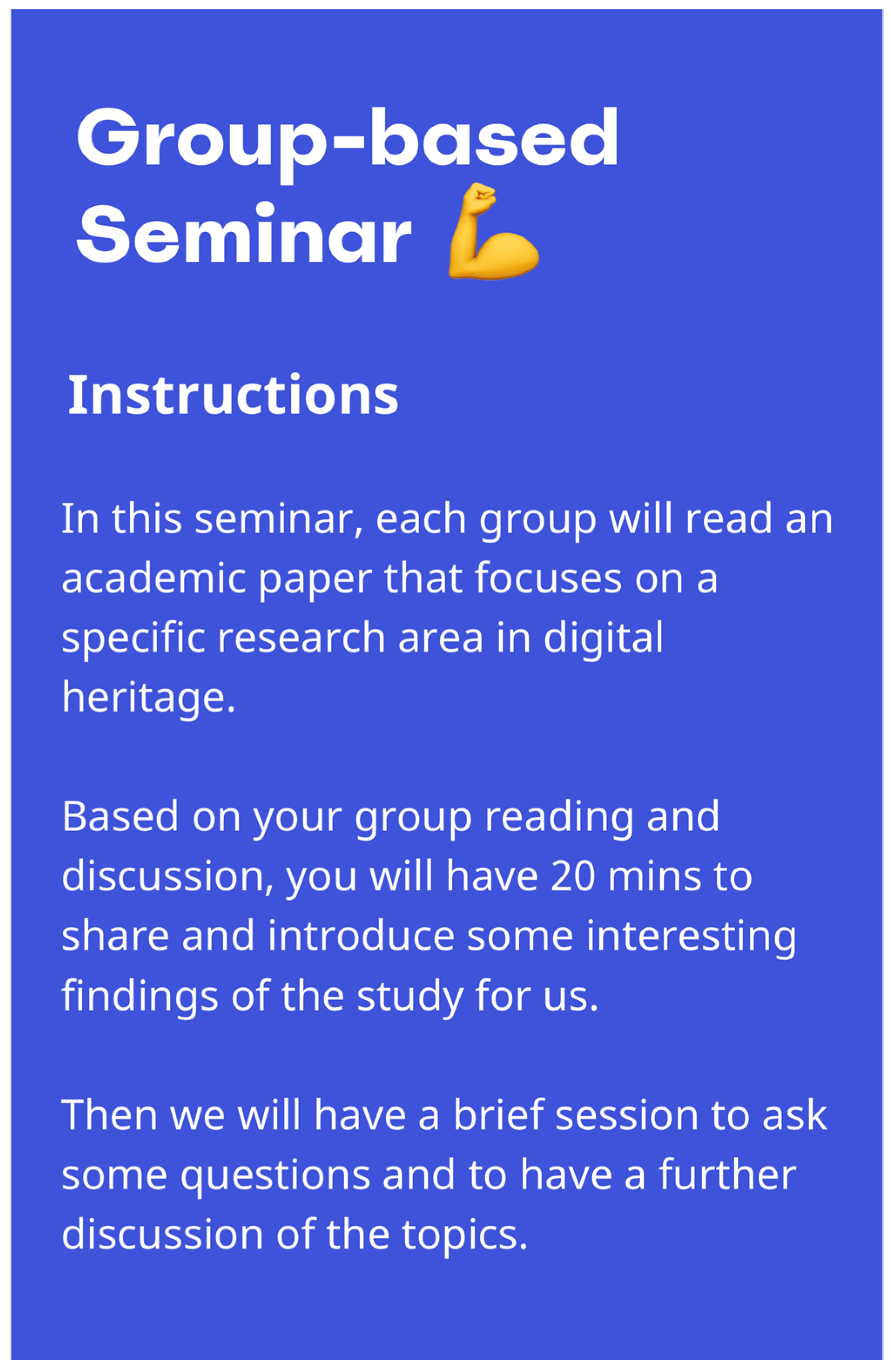
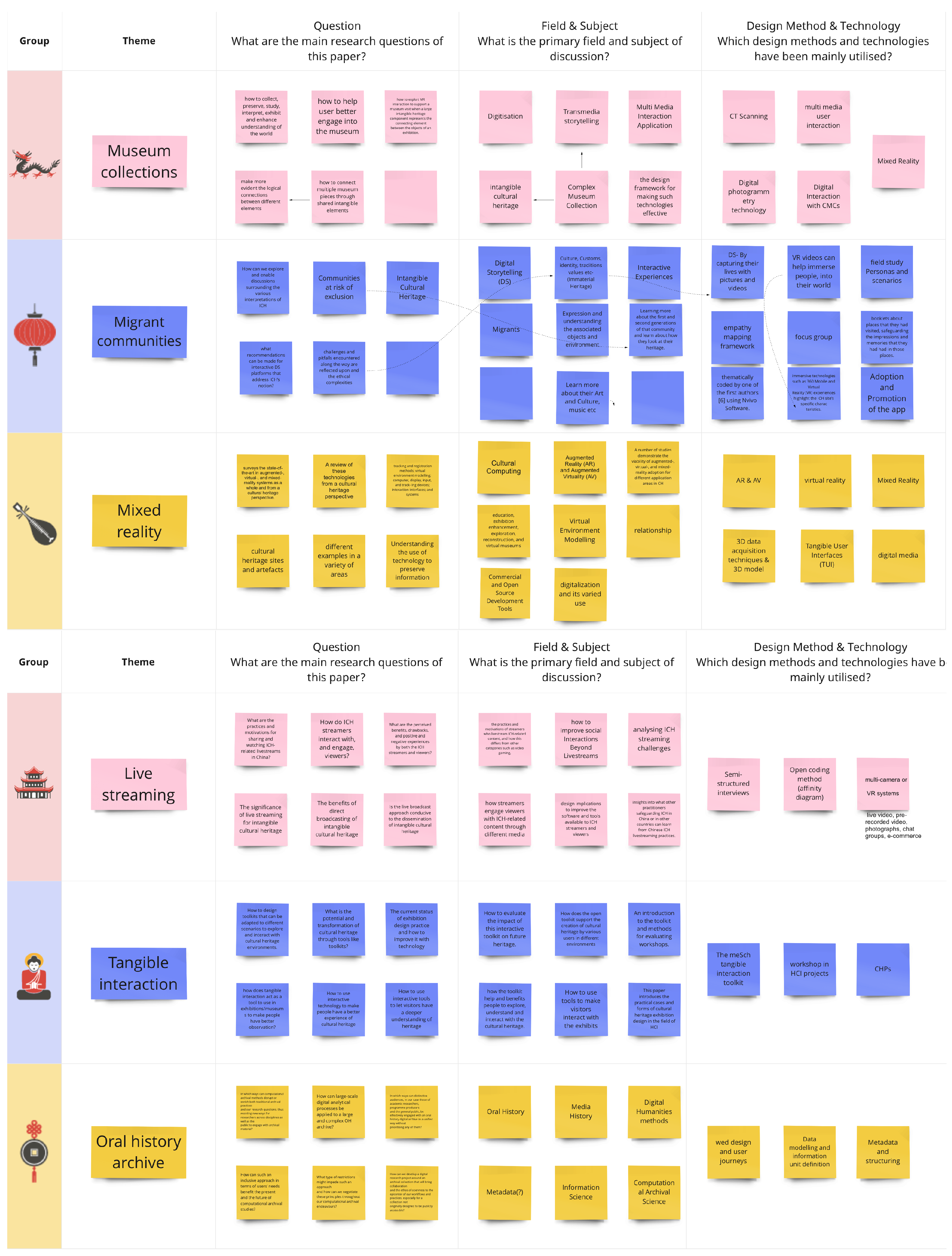
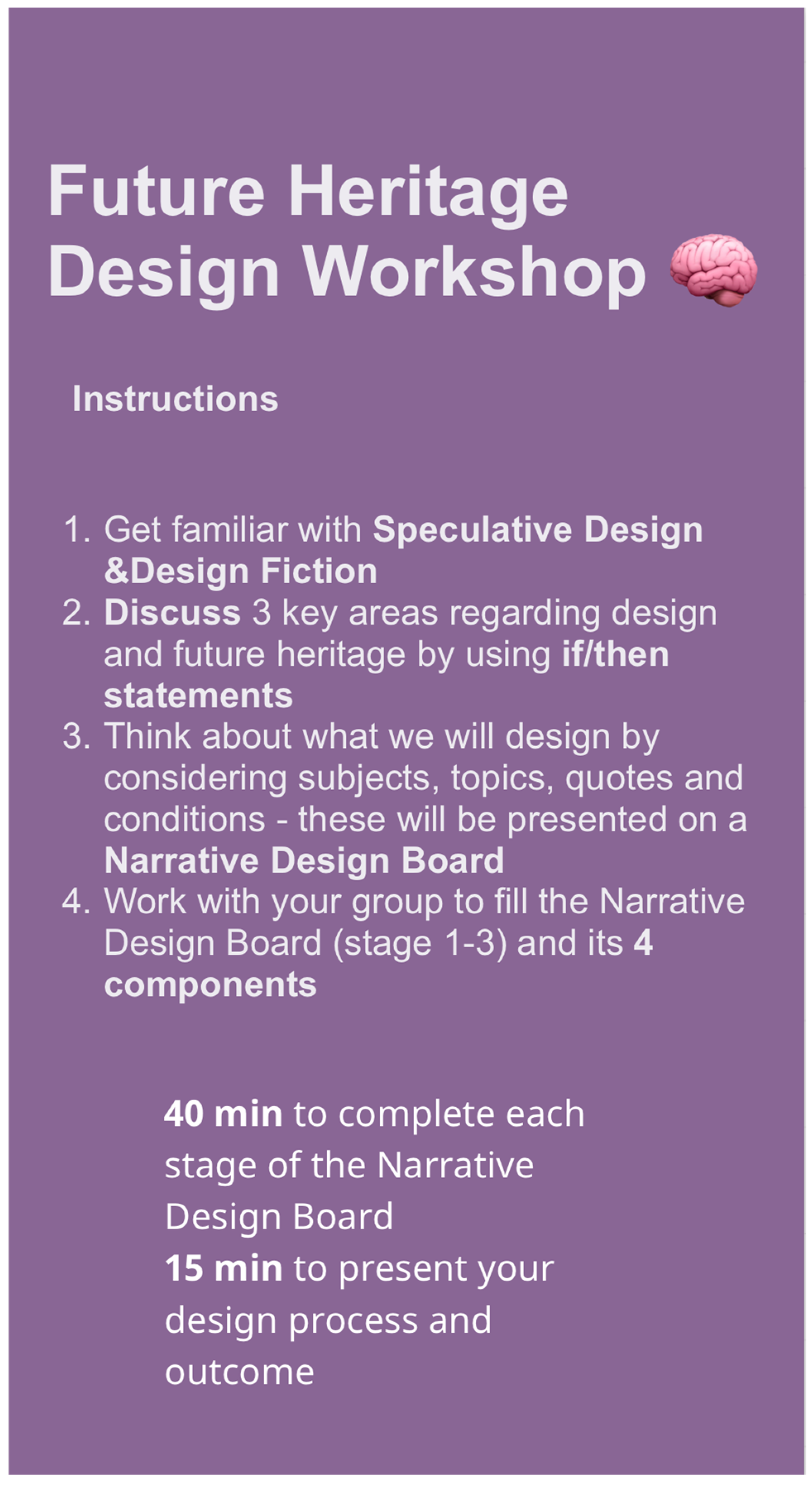
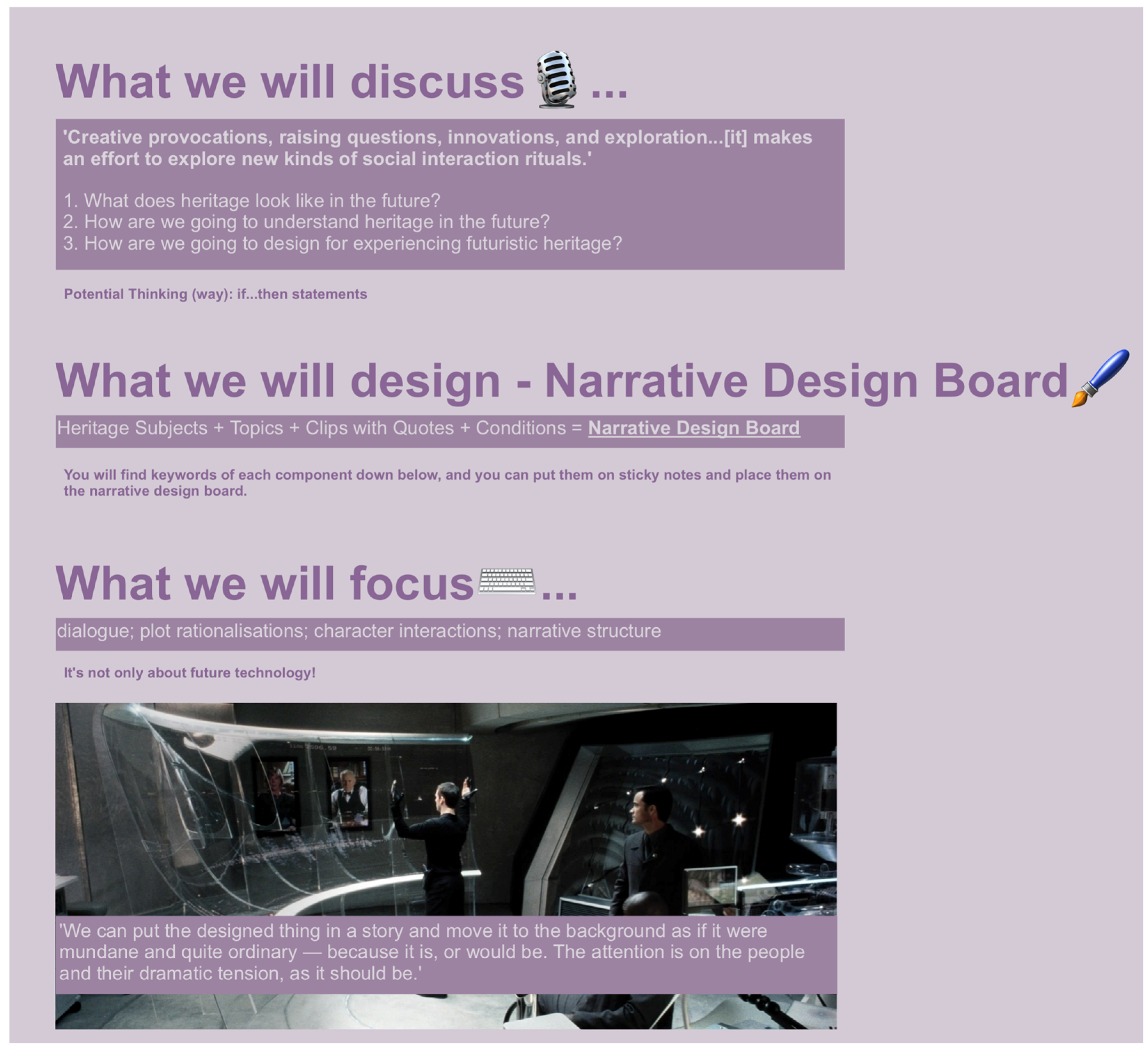
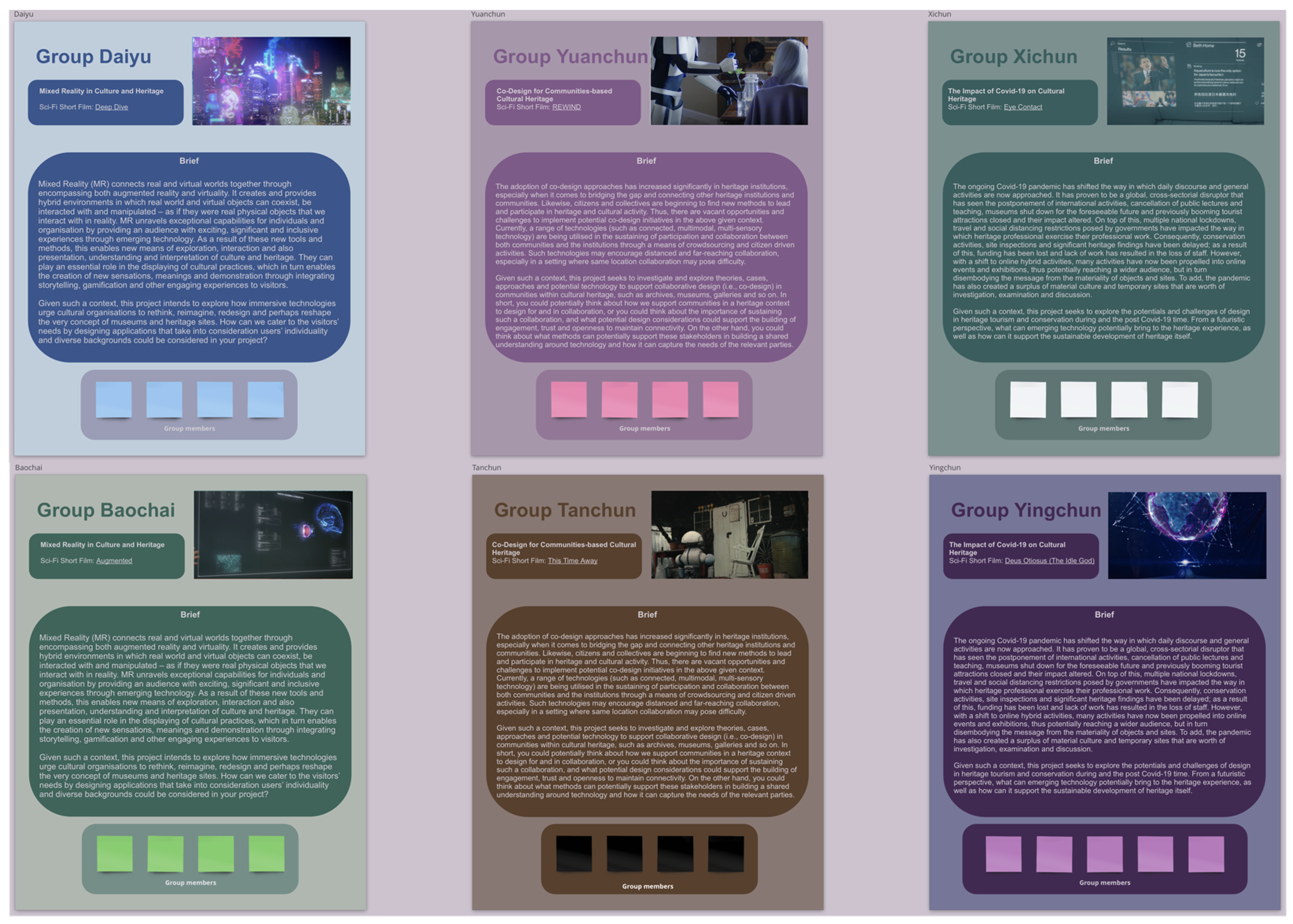
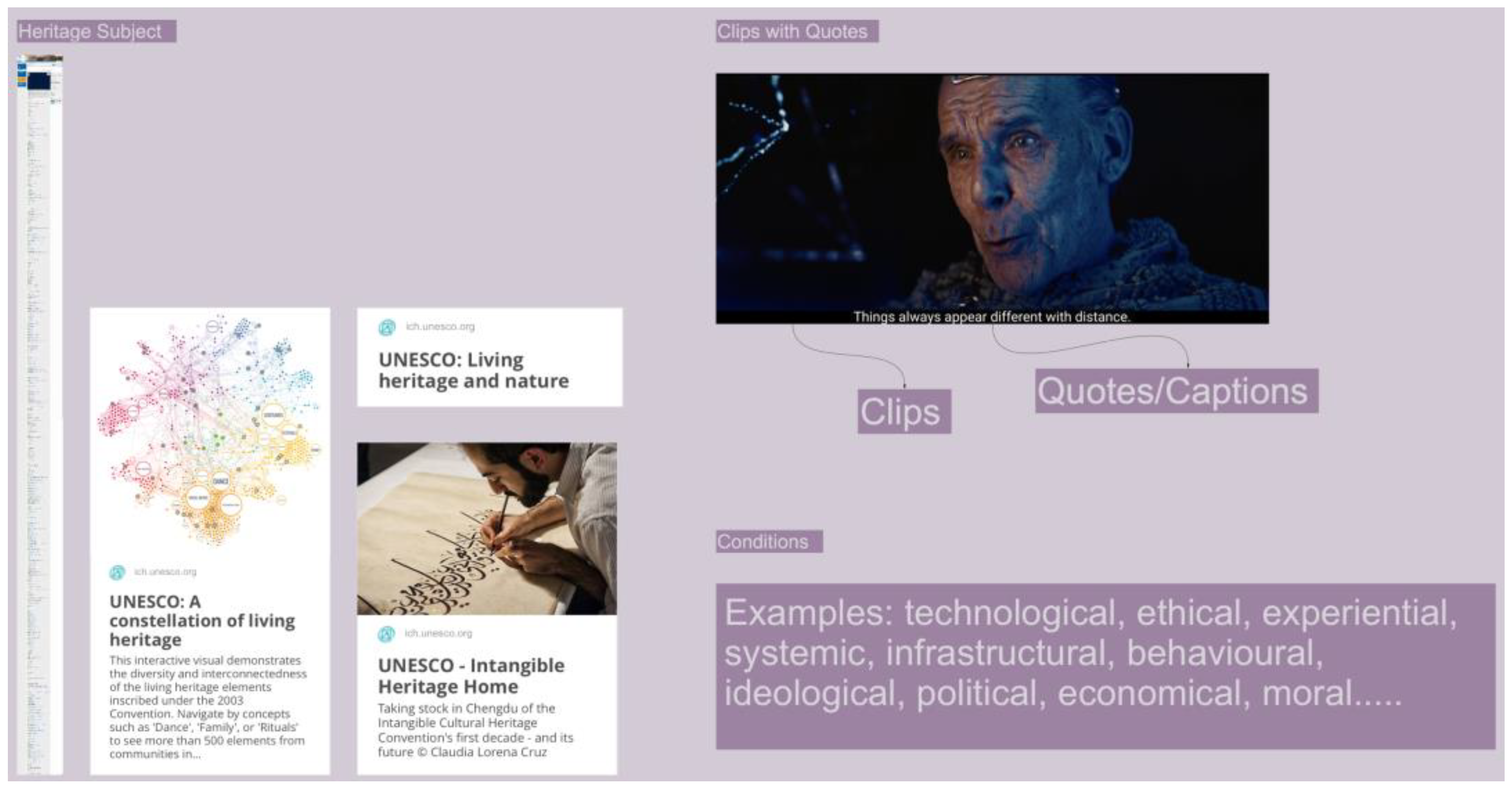


| Activity | Time Duration | Software Selection | Outcome |
|---|---|---|---|
| Peer Sharing | 2 h | Zoom, Miro | Whiteboard |
| Literature-based Seminar | 2 h (pre-activity) + 3 h | Zoom, Miro | Whiteboard, Presentation |
| Future Heritage Design Workshop | 1 h (pre-activity) + 4 h | Zoom, Miro, YouTube | Whiteboard, Prototype, Presentation |
| No. | Gender | Academic Background | Cultural Background |
|---|---|---|---|
| 1 | F | Interaction Design | UK |
| 2 | M | Interaction Design | China |
| 3 | F | Interaction Design | China |
| 4 | F | Interaction Design | China |
| 5 | F | Interaction Design | India |
| 6 | F | Interaction Design | UK |
| 7 | F | Service Design | UK |
| 8 | M | Service Design | China |
| 9 | F | Service Design | India |
| 10 | F | Service Design | Pakistan |
| 11 | F | Service Design | Greece |
| 12 | M | Interior Design | UK |
| 13 | M | Interior Design | China |
| 14 | F | Interior Design | India |
| 15 | F | Interior Design | India |
| 16 | F | Interior Design | China |
| 17 | M | Interior Design | Italy |
| 18 | M | Graphic Design | China |
| 19 | F | Graphic Design | UK |
| 20 | F | Graphic Design | UK |
| 21 | F | Heritage Visualisation | Pakistan |
| 22 | F | Heritage Visualisation | India |
| 23 | M | Heritage Visualisation | UK |
| 24 | F | Product Design | UK |
| 25 | M | Product Design | UK |
| 26 | F | Curatorial Practice | France |
Publisher’s Note: MDPI stays neutral with regard to jurisdictional claims in published maps and institutional affiliations. |
© 2022 by the author. Licensee MDPI, Basel, Switzerland. This article is an open access article distributed under the terms and conditions of the Creative Commons Attribution (CC BY) license (https://creativecommons.org/licenses/by/4.0/).
Share and Cite
Zhao, S. Creating Futuristic Heritage Experiences: An Exploratory Co-Design Study through Design Fiction. Sustainability 2022, 14, 12027. https://doi.org/10.3390/su141912027
Zhao S. Creating Futuristic Heritage Experiences: An Exploratory Co-Design Study through Design Fiction. Sustainability. 2022; 14(19):12027. https://doi.org/10.3390/su141912027
Chicago/Turabian StyleZhao, Shichao. 2022. "Creating Futuristic Heritage Experiences: An Exploratory Co-Design Study through Design Fiction" Sustainability 14, no. 19: 12027. https://doi.org/10.3390/su141912027
APA StyleZhao, S. (2022). Creating Futuristic Heritage Experiences: An Exploratory Co-Design Study through Design Fiction. Sustainability, 14(19), 12027. https://doi.org/10.3390/su141912027








